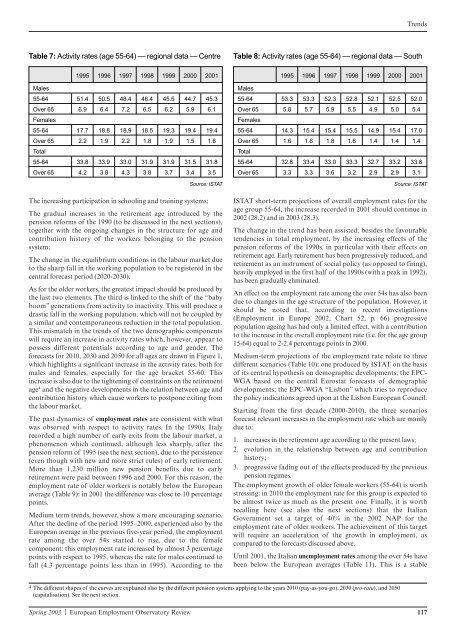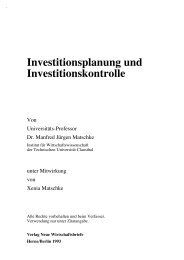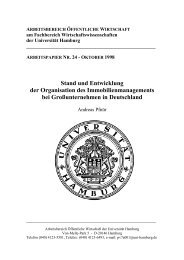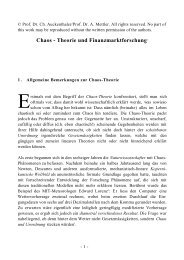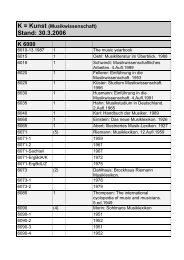FRANCE The
FRANCE The
FRANCE The
You also want an ePaper? Increase the reach of your titles
YUMPU automatically turns print PDFs into web optimized ePapers that Google loves.
Table 7: Activity rates (age 55-64) — regional data — Centre<br />
Males<br />
1995 1996 1997 1998 1999 2000 2001<br />
55-64 51.4 50.5 48.4 46.4 45.5 44.7 45.3<br />
Over 65 6.9 6.4 7.2 6.5 6.2 5.9 6.1<br />
Females<br />
55-64 17.7 18.8 18.9 18.5 19.3 19.4 19.4<br />
Over 65 2.2 1.9 2.2 1.8 1.9 1.5 1.6<br />
Total<br />
55-64 33.8 33.9 33.0 31.9 31.9 31.5 31.8<br />
Over 65 4.2 3.8 4.3 3.8 3.7 3.4 3.5<br />
Source: ISTAT<br />
<strong>The</strong> increasing participation in schooling and training systems;<br />
<strong>The</strong> gradual increases in the retirement age introduced by the<br />
pension reforms of the 1990 (to be discussed in the next sections),<br />
together with the ongoing changes in the structure for age and<br />
contribution history of the workers belonging to the pension<br />
system;<br />
<strong>The</strong> change in the equilibrium conditions in the labour market due<br />
to the sharp fall in the working population to be registered in the<br />
central forecast period (2020-2030).<br />
As for the older workers, the greatest impact should be produced by<br />
the last two elements. <strong>The</strong> third is linked to the shift of the “baby<br />
boom” generations from activity to inactivity. This will produce a<br />
drastic fall in the working population, which will not be coupled by<br />
a similar and contemporaneous reduction in the total population.<br />
This mismatch in the trends of the two demographic components<br />
will require an increase in activity rates which, however, appear to<br />
possess different potentials according to age and gender. <strong>The</strong><br />
forecasts for 2010, 2030 and 2050 for all ages are drawn in Figure 1,<br />
which highlights a significant increase in the activity rates, both for<br />
males and females, especially for the age bracket 55-60. This<br />
increase is also due to the tightening of constraints on the retirement<br />
age4 and the negative developments in the relation between age and<br />
contribution history which cause workers to postpone exiting from<br />
the labour market.<br />
<strong>The</strong> past dynamics of employment rates are consistent with what<br />
was observed with respect to activity rates. In the 1990s, Italy<br />
recorded a high number of early exits from the labour market, a<br />
phenomenon which continued, although less sharply, after the<br />
pension reform of 1995 (see the next section), due to the persistence<br />
(even though with new and more strict rules) of early retirement.<br />
More than 1,230 million new pension benefits due to early<br />
retirement were paid between 1996 and 2000. For this reason, the<br />
employment rate of older workers is notably below the European<br />
average (Table 9): in 2001 the difference was close to 10 percentage<br />
points.<br />
Medium term trends, however, show a more encouraging scenario.<br />
After the decline of the period 1995–2000, experienced also by the<br />
European average in the previous five-year period, the employment<br />
rate among the over 54s started to rise, due to the female<br />
component: this employment rate increased by almost 3 percentage<br />
points with respect to 1995, whereas the rate for males continued to<br />
fall (4.3 percentage points less than in 1995). According to the<br />
Spring 2003 | European Employment Observatory Review 117<br />
Trends<br />
Table 8: Activity rates (age 55-64) — regional data — South<br />
1995 1996 1997 1998 1999 2000 2001<br />
ISTAT short-term projections of overall employment rates for the<br />
age group 55-64, the increase recorded in 2001 should continue in<br />
2002 (28.2) and in 2003 (28.3).<br />
<strong>The</strong> change in the trend has been assisted, besides the favourable<br />
tendencies in total employment, by the increasing effects of the<br />
pension reforms of the 1990s, in particular with their effects on<br />
retirement age. Early retirement has been progressively reduced, and<br />
retirement as an instrument of social policy (as opposed to firing),<br />
heavily employed in the first half of the 1990s (with a peak in 1992),<br />
has been gradually eliminated.<br />
An effect on the employment rate among the over 54s has also been<br />
due to changes in the age structure of the population. However, it<br />
should be noted that, according to recent investigations<br />
(Employment in Europe 2002, Chart 52, p. 66) progressive<br />
population ageing has had only a limited effect, with a contribution<br />
to the increase in the overall employment rate (i.e. for the age group<br />
15-64) equal to 2-2.4 percentage points in 2000.<br />
Medium-term projections of the employment rate relate to three<br />
different scenarios (Table 10): one produced by ISTAT on the basis<br />
of its central hypothesis on demographic developments; the EPC-<br />
WGA based on the central Eurostat forecasts of demographic<br />
developments; the EPC-WGA “Lisbon” which tries to reproduce<br />
the policy indications agreed upon at the Lisbon European Council.<br />
Starting from the first decade (2000-2010), the three scenarios<br />
forecast relevant increases in the employment rate which are mainly<br />
due to:<br />
1. increases in the retirement age according to the present laws;<br />
2. evolution in the relationship between age and contribution<br />
history;<br />
3. progressive fading out of the effects produced by the previous<br />
pension regimes.<br />
<strong>The</strong> employment growth of older female workers (55-64) is worth<br />
stressing: in 2010 the employment rate for this group is expected to<br />
be almost twice as much as the present one. Finally, it is worth<br />
recalling here (see also the next sections) that the Italian<br />
Government set a target of 40% in the 2002 NAP for the<br />
employment rate of older workers. <strong>The</strong> achievement of this target<br />
will require an acceleration of the growth in employment, as<br />
compared to the forecasts discussed above.<br />
Until 2001, the Italian unemployment rates among the over 54s have<br />
been below the European averages (Table 11). This is a stable<br />
4 <strong>The</strong> different shapes of the curves are explained also by the different pension systems applying to the years 2010 (pay-as-you-go), 2030 (pro-rata), and 2050<br />
(capitalisation). See the next section.<br />
Males<br />
55-64 53.3 53.3 52.3 52.8 52.1 52.5 52.0<br />
Over 65 5.8 5.7 5.9 5.5 4.9 5.0 5.4<br />
Females<br />
55-64 14.3 15.4 15.4 15.5 14.9 15.4 17.0<br />
Over 65 1.6 1.6 1.8 1.6 1.4 1.4 1.4<br />
Total<br />
55-64 32.8 33.4 33.0 33.3 32.7 33.2 33.8<br />
Over 65 3.3 3.3 3.6 3.2 2.9 2.9 3.1<br />
Source: ISTAT


